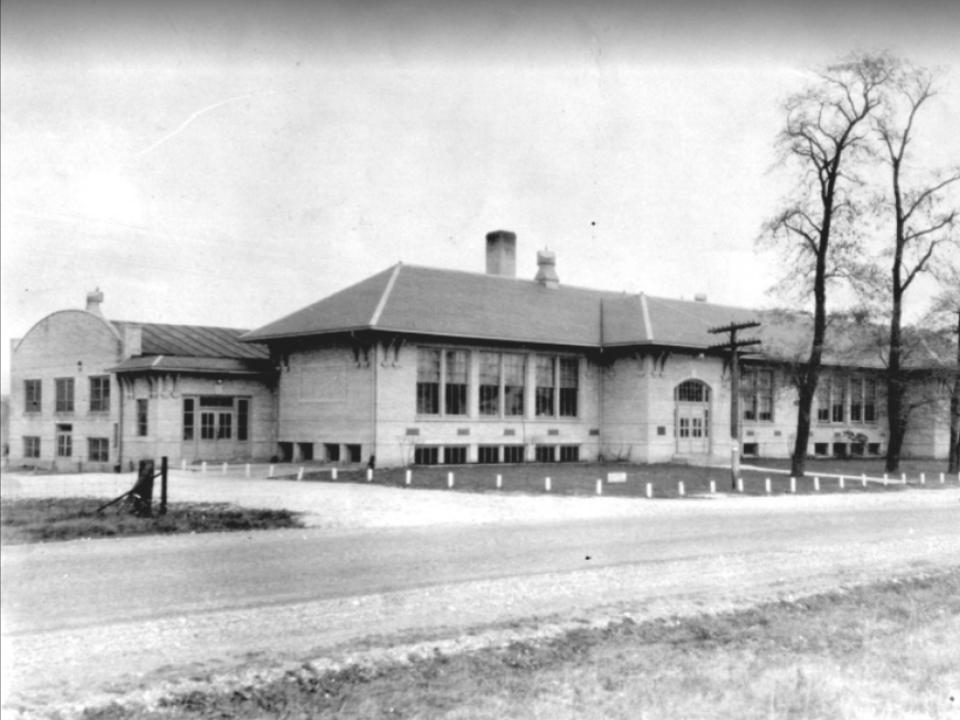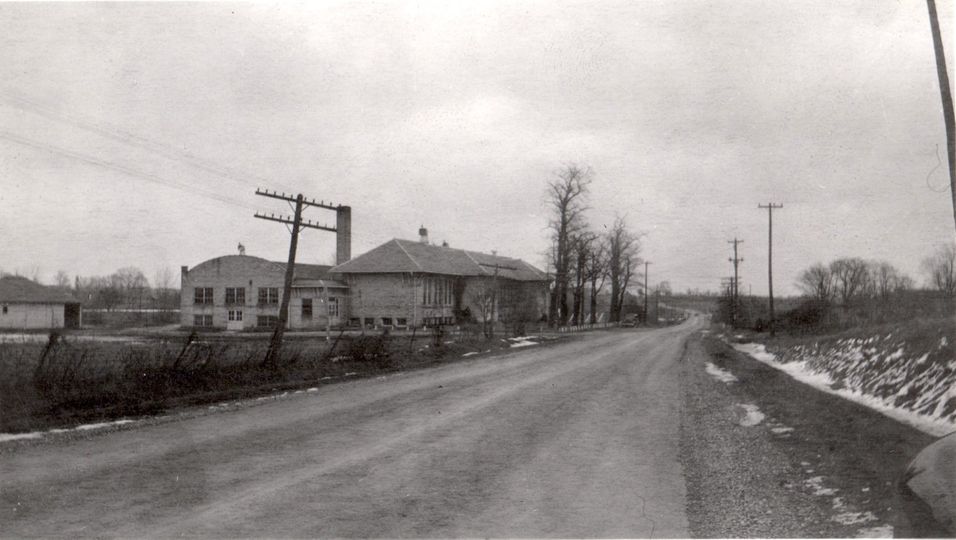When you drive along the well-kept roads bordering the farms and businesses of Washington Township today, it’s hard to imagine mastodons roaming the fields or Potawatomi Indians battling the Fox from Illinois in a bloody boundary dispute.
The National Geographic Society says the first human inhabitants of the area came shortly after the melting of the glaciers over 5,000 years ago. An almost perfect skeleton of a mastodon was unearthed during dredging on Cooper’s Washington Township farm in 1911. One of the massive bones was displayed in the Valparaiso Public Library history room.
The Indian battlefield, later known as Morgan Prairie, was a stretch of field and forest unbroken by a plow. The agreed-upon "best two out of three battles" took 500 native American lives. The bodies that could be retrieved were buried along the Kankakee River. The skeletons found abandoned in a marshy area of the battlefield on the moraine ridge set the date of the boundary war in the summer of 1776.
In 1776, few Europeans had ventured into the Northwest Territory. No permanent white settlement had been made in the area.
About 100 Indians lived in the marshes and forests near present-day Route 30 in the early 1800s where busy highways and shopping centers now obliterate a Potawatomi village, hunting grounds and graveyards. Chief Strongbow lived near the site of the restaurant that bears his name.
Porter County was formed from part of LaPorte County in 1836. Washington Township was then organized by the Commissioners of Porter County who named the township in honor of George Washington. The township boundaries were 600 North, 200 East, County Line Road and Division Road including 30 square miles.
A pioneer village called Prattville, consisting of a general store and a saw mill, was located about a mile from the present Washington Township School site. Several trading posts and tradesmen sprung up along the ancient Indian Sauk Trail while early settlers hunted their food and acquired farmlands. An ox cart and wagon trail passed through Prattville until 1859. The settlement was a covered wagon stop on the trail to Oregon and other destinations west. The Sauk Trail is now Indiana State Route 2.
The township’s first white settlers were brothers William and Isaac Morgan who settled on land north of the Sauk Trail in 1833. The land was known as Morgan Prairie.
Most county historians agree that the first township school was taught by Mary Hammond in a log house built by A.V. Bartholomew on Ruel Starr’s property during the winter of 1835-36. The next school was taught by Thomas Campbell in an 18x20-foot log house on the Kimmerer farm. This school was taught for one term.
The Morgan property was taken over by Wilson Malone who owned much of the land that is now Valparaiso. Malone gave his land and name to the first log cabin school built in the township in 1836 for $25. The school was on the site that later became Washington Township School when the district schools consolidated in 1911.
The children of four families attended the school for three months during the winter. The children were needed to work on the family farms during the rest of the year.
There were no public funds for teachers in 1836. In these early times, residents voted down a tax on all citizens to pay for the schools. The teacher was paid by subscription--$2 per student per month, about $10 to $12 monthly.
Goodspeed’s "History of Lake and Porter County" in 1882 states that "this sum was considered sufficient to pay the teacher who was required to wield the birch (switch) with sufficient force to overcome the unruly young man of twenty summers."
Later, educated men traveling west often taught school when they stopped for the winter. Men were paid more than women when salaries were established, though there were always more women teachers than men. Later some restrictions were placed on women teachers’ behavior and lifestyles. Licenses became required in the 1890s.
Washington Township Teacher Contracts: 1899 - 1907
The early inhabitants wanted to provide an education for their children and established seven one- and two-room schools throughout the township by the 1880s. New schools were built as public school funds became available. Some of the funds before the Civil War came from fines paid to the Justices of the Peace by violators of the "Sabbath Breaking" law.
The first schoolhouse built in Washington Township was probably Morgan schoolhouse in about 1836 or 1837. The Luther schoolhouse was built about the same time in the mid- to late-1830s.
The typical first schools were log buildings on land donated by landowners, usually those with children who would attend the school. Neighbors got together and "raised" the school. A typical school building was a simple room with one log left out in each wall for a window. These openings and the door were covered with oiled paper or cloth, glass being a costly luxury.
There was a fireplace at one end of the room. The students rolled large logs into the fireplace.
Luther School was described by an early student as having long seats around the room with desks in front of them. Here students copied the teacher’s writing. Subjects commonly taught were reading, writing, spelling and arithmetic. A pupil who reached the level of the Rule of Three was considered a fine mathematician.
The log cabin schools were replaced by frame, then brick buildings as they burned down or became too small for their student population. The schools were typically on one-acre plots with enough room for a small playground for 15 to 30 students.
Some of the games played at recess sound familiar—London Bridge and Farmer in the Dell. Others like Dare Base, Pump, Pump Pull Away and Old Maid Baseball have given way to soccer, baseball and football.
At night the schools hosted spelling bees as well as writing and singing schools. Schoolhouses were often used as churches.
Though the township started with only two schools, by 1882 there were seven "well-conducted, neat and commodious schools," as reported in Goodspeed’s history.
By then, there were seven district schools scattered throughout the 30 square miles of the township. No student had to walk more than three or four miles to their school. Some students rode horses to school. Sometimes the horses then returned to work on the farm until school was excused for the day.
Hansford School was District 1. Located at 575 East, southeast of State Road 2, the school was named for the landowner, John Hansford, who owned 900 acres of farmland. He came from England in 1842 and was an employee of the Grand Trunk Railroad, one of the railroads running through the township.
District 2, Malone School, became Washington Township School when five districts consolidated in 1911. Wilson Malone was a Porter County pioneer, coming from Ohio in the 1830s. He took over Morgan’s land.
District 3 was the Luther School, one of the first two schools built in the township. Named for John Luther, it was built next to the cemetery where many Porter County pioneers are buried. It is located on 100 North and 400 East, southeast of the airport.
Prattville School, District 4, was also called Kemmerer. The red-frame schoolhouse was on the north side of Route 2, west of 325 East. It was located one mile southwest of the current Washington Township Schools. Early students were sometimes "bussed" to school at Prattville School in stage coaches.
Brierly School in District 5 burned down when it was struck by lightning in a 1903 summer storm. It was located on 450 East and 500 North. The Brierly descendants were members of the Farmers’ Association in 1921.
Island School, District 6, was known as Snake Island School. Located at 575 East, south of 150 North, the school was near the site of an ancient island where the snakes of the marsh gathered to warm up in the sun. The island also housed the teepee of an Indian medicine woman in earlier days. The red-brick school with arched windows was replaced by a housing development. It was torn down in the late 1970s - early 1980s.
Blake School, District 7 was located in the northwest corner of the township on 300 East and 500 North (Burlington Beach Road).
A.J. Bowser, long-time editor of the "Chesterton Tribune" and popular "Siftings" columnist for the "Vidette-Messenger" in the 1930s wrote, "The struggles of the people of Washington Township to secure educational facilities for their children has been the story of all the rest of the new country."
Researched and written January 2002
Beverly Overmyer



